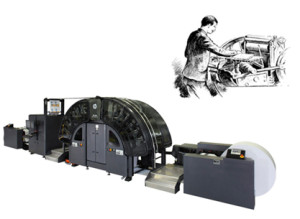Printing and its part in the information age
 The first printing press gave rise to the first Information Age
The first printing press gave rise to the first Information Age
These days there’s a lot of talk about the Information Age. But what many folks forget is that there was another Information Age. Most people don’t recall it because it happened long, long ago, but it had a major impact on the world much like the current one is having. The first Information Age began with the invention of the printing press around 1440 by Johann Gutenberg. The inspiration behind Gutenberg’s discovery was his belief that he could make lots of money by creating mass amounts of a cheap product. In his case it was all about printed words, while today’s Information Age is all about the digital word. Even with the great shift towards digital, the printed word still plays an important role in communicating information to people. To find out how, and how when combined, the two help make each other more effective, read on…
 Printing has changed but the principles remain the same
Printing has changed but the principles remain the same
Long before the invention of the printing press, cave men drew images on cave walls as a way to communicate with others. Long after that, words and images were created painstakingly by hand. Back then, only a select few had the right to do this. Mainly it was monks who lived and worked in monasteries. They were known as scribes and they toiled away in rooms that were called scriptoriums. The job of the scribes was to measure and outline the page layouts and then copy text from other books. Once that was done, illuminators added designs and embellishments to the pages. It wasn’t mass production, but that didn’t matter because this form of printing was so costly that only a few could afford these books. They were mainly owned by monasteries, educational institutions, or extremely wealthy individuals and families.
It was only a matter of time before printing improved
Enter the aforementioned Johann Gutenberg. Before he invented the printing press, people had graduated from the scribe and illuminator method of printing books to a technique that involved letters or images cut on blocks of wood, which would be dipped in ink and then stamped onto paper. Gutenberg, who had worked at a mint, thought that if he could use cut blocks in a machine of some sort, he could speed up the printing process. He believed that with faster printing he would be able to reproduce texts in large quantities (and make large quantities of money by selling them). Instead of using wooden blocks Gutenberg employed metal, which was moveable. The ability to move the metal around to create new words and sentences caused his invention to be called the movable type machine.
The progress of the printing press continued
When the notion of printing presses picked up steam, it gave rise to a new trade—the printing industry. Printed texts became a new way to spread information to vast audiences quickly and cheaply. This benefited academics wgo could now spread scholarly ideas. Politicians also found that they could campaign more effectively through the use of printed pamphlets. With printed texts available to one and all, instead of just to those who were wealthy, average people began improving their ability to read, and by doing so gained more knowledge.
The first Information Age paved the way for the second
The history of printing now takes us to today. As we know, we’re presently in the throes of a second Information Age; one that’s been propelled in great part by the Internet and the technologies it has helped to spawn, namely Facebook, Twitter, YouTube, and countless other ways to communicate ideas, and to sell products and services. Just as early printing presses helped to create a communications revolution back in their day, current digital technology, specifically the Internet, is having an equally large effect on how people are getting their information.
Even with the freedom, access, and control that the Internet provides, there are also downsides, just as there were during the first Information Age when the growth of printing presses gave rise to propaganda wars and secret societies. With the Internet, the downsides have changed, but they are not to be dismissed. Today, the concerns center on security, online terrorism, viruses, loss of privacy, incorrect and harmful information, and censorship, as well as the lack of it. Other downsides include scam artists, misleading information and statistics, and Web site sabotage. Even with its downsides, the second Information Age will continue to influence how we communicate long into the future, much like the first Information Age did.
Two Information Ages co-existing in the 21st Century
The Internet has caused the amount of information to grow substantially (think, Big Data). It’s also made it super fast and easy to access information. And, it’s made it all instant and interactive, allowing for immediate feedback, and enticing the user in a different way than in the past. However, even with all that the Internet offers, we haven’t bid adieu to the printing press. In fact, when combined, they offer marketers a host of new ways to get the word out—there’s variable printing, print on-demand, web-to-print, and the list goes on. It’s safe to say that we have two Information Ages going on simultaneously, making this a pretty special time to be alive.
 Let’s connect
Let’s connect
If you’d like to learn more about how we think here at Ferrante & Associates, subscribe to our blogs or our monthly Newsletter Ferrante Speaks. You may also follow us on Twitter, Google+ or Facebook.
Don’t miss out: Subscribe and receive regular updates delivered automatically via a web portal, newsreader or email.







